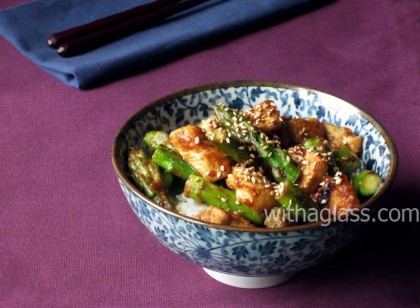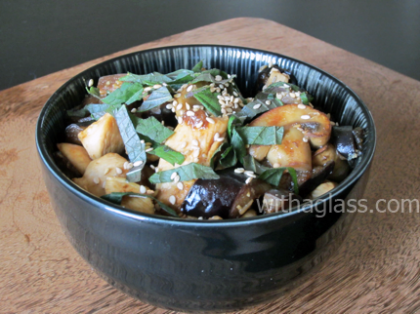Chicken and Leek in Miso and Honey Sauce

This recipe might be very simple, but it solves a very serious question: “what else to do with a big tube of miso?”. Even if I love miso soup, I don’t have it regularly, so I always look for new ideas, especially since I buy several tubs of miso every year in Japan. Like the majority of Japanese dishes, this one is quick to prepare and requires very few ingredients. Apart from being practical, it’s absolutely delicious and crowd-pleasing, the latter not being the case of all the Japanese dishes…
I found it in a video, on one of my favourite Japanese websites “Three-Minute Cooking” (3分クッキング, only in Japanese). The vegetable used in the original recipe is called negi and it’s usually substituted in Western countries either by leek or white part of green onions. This time I have used young thin leeks, but you can try it with thick white and whiteish parts of green onion. As always, I’ve tweaked the proportions of the ingredients and in general slightly changed the cooking process, so – if you read or/and understand Japanese – make sure you visit the 3分クッキング website.
If you look for some other miso cooking ideas, you might like some of these:










TIPS: The Japanese love soft chicken skin. I don’t. I like it only when crisp and grilled, so I’ve skipped it here. I’ve also substituted chicken breast for chicken leg because I prefer it in quick stir-fried dishes. Choose whichever you prefer.
I’ve added even more chilli than in the original recipe, but you can leave all the chilli out if you prefer.
Preparation: about 20 minutes (+15 marinating time)
Ingredients : (serves two)
white and whiteish parts of 4 thin leeks, cut into bite-sized pieces (or the same parts of 8-10 thick green onions)
1 big chicken breast
oil
Marinade:
2 tablespoons low-sodium soy sauce (or 1 tablespoon, if your soy sauce is standard)
2 tablespoons cooking (i.e. cheap) sake (not mirin, which is sweet cooking sake because the honey already makes this dish sweet enough)
Miso sauce:
4 tablespoons miso (I have used red miso)
1 tablespoon crushed garlic
1 teaspoon grated fresh ginger
1 tablespoons cooking sake (not mirin)
2 tablespoons honey
(1 teaspoon chilli flakes or crushed dried medium hot chilli pods)
Cut up the chicken breast into bite-sized pieces.
Combine with sake and soy sauce and put aside for 15 minutes.
In the meantime prepare the miso sauce, combining all its ingredients.
Heat 1 tablespoon oil and stir-fry the leek pieces until slightly browned.
Take them out of the pan.
Add more oil if needed and stir-fry the chicken pieces until half-cooked.
Add the miso sauce and the leek and let the dish simmer at low temperature until the chicken is cooked.
What a great way to use up miso. I love miso soup too but I try not to have it too often because of its high salt content. I have also experimented with various types of miso but I always keep coming back to the light light-colouored organic miso.
Thanks a lot, Eva. Too much salt is one of the rare unhealthy sides of the Japanese diet… mainly because of miso soup, but also daily intake of pickles if I remember well (salt pickles mainly). As for the miso soup, ready-to-use dashi powder – used by most Japanese households – usually contains salt (there are now law-salt options too). When one makes dashi at home it’s salt-free (at least mine), so the only salty part is miso paste…
My favourite miso is red because it has stronger flavours and I love especially the slightly gritty kind, not smooth… Since I don’t use it very often, I don’t worry about the salt content too much. I have been using low-sodium soy sauce for many years though because I use it almost every day in many cuisines (even Italian or Polish!). I’ve realised I find the normal soy sauce now horribly salty in comparison!
I totally understand what you mean about the regular soy sauce, but it’s good to read the labels because here, our low sodium soy sauce (name brand) actually has more sodium than the regular no-name brand soy sauce! Strange but true. I will be making dashi soon, I had wanted to buy some ready made powder but MSG was the very first ingredient on the list, and it actually makes me feel terrible so I try not to buy sauces that contain MSG.
This is weird… I had no idea there are such big differences between brands! I have been buying Yamasa low-sodium sauce (my favourite) for years and the salt content is clearly written: it’s about 40-45% less than their regular soy sauce. (The most famous Kikkoman is slightly more salty, the difference is about 10% I think).
I don’t know if you’ve tried doing it, but homemade dashi keeps about a week in the fridge and it freezes well too (like any other stock). I always make at least 2 litres (primary and secondary dashi). I’ve never bought powdered dashi simply because it’s very expensive here compared to homemade one and then I kept on doing it….
As for MSG, the only product where I don’t mind it in my Japanese mayonnaise! It’s the best in the world!
Delicious looking dish. I keep both the white and the red miso in my freezer for when I get the craving for some miso soup but I’d like to try something different with it like this.
Thank you, A_Boleyn. Luckily there are many ways to use miso, especially as the main ingredient of a sauce.
Delicious looking dish, but it is so difficult to find good miso here, only in Metro and I found it disgusting compared to the stuff I bought in England the last time we were there. Unfortunately I don’t remember the brand so I cannot search for it online either. Can you recommend a good one that I could order online?
Thanks a lot, Adina! I’ve been bringing different brands of miso every year from my trips to Japan and haven’t seen these in Europe, but I remember I used to buy this brand before here in Switzerland and liked it a lot:
https://www.amazon.co.uk/Hikari-organic-miso-750g-NATURAL/dp/B016M6K17M/ref=sr_1_2_a_it?ie=UTF8&qid=1521824671&sr=8-2&keywords=miso
(Haven’t seen it on German Amazon, but I think they ship it to Germany).
I wonder if it’s the same kind of miso, but in a plastic bag:
https://www.amazon.de/Hikari-Sojapaste-Miso-rot-400g/dp/B007GGLV5Y/ref=sr_1_2?s=grocery&ie=UTF8&qid=1521824925&sr=1-2&keywords=hikari+miso
It’s smaller, so much more expensive…
I hope you will like it too. Write to me if you have any questions!
I’ve just checked and I think the one in the bag is a different quality (might be lower…) miso. In short I recommend the plastic container (I’ve never bought the bag).
Thank you, Sissi. I had a look online and found organic hikari red paste to buy in Germany. The container looks a bit different, but it’s hikari red, so I hope it is just as good. Can’t wait to have it! 🙂
Good luck! I cross my fingers and hope we don’t have different tastes…
What a great dish!!! I just happen to have a bag of red miso in the fridge that has been in there for a couple of years and this recipe is perfect. Quick & easy, spicy and lots and lots of flavor. Not surprised that you doubled the chilli. 🙂 So it this served best with a bowl of sticky rice?
Thank you so much, MJ. Yes, short-grain slightly sticky Japanese rice is the best (but I’m biased… this is the only type of rice I like), but it can be served with anything really.
Only recently have I tried miso and loved it! This is a keeper!
Thank you, Katerina.